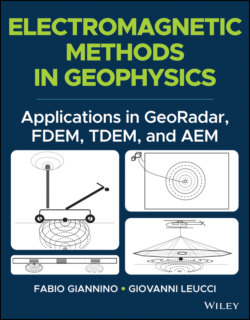Читать книгу Electromagnetic Methods in Geophysics - Fabio Giannino - Страница 22
2.2.4. The EM signal with respect to the depth
ОглавлениеAs already shown in Figure 2.2.6, transmitting and receiving coils may be deployed in a vertical dipole as well as in a horizontal dipole mode. In the first case (Figure 2.2.6– 1, coils horizontal co‐planar), the vertical dipole mode data acquisition will be configured, whereas in the second (Figure 2.2.6– 2, coils vertical co‐planar), the horizontal dipole mode shall be deployed.
In both cases, the response, given in terms of contribution to the secondary magnetic field Hs, of a single thin layer located at an increasing depth within the system where the EM signal propagates, differs according to the burial depth of the thin layer itself.
In Figure 2.2.7 is illustrated (J.D. McNeill, 1980) how the above‐mentioned contribution to the secondary magnetic field varies with respect to acquisition mode (dipole orientation) and investigation depth. The graph shows along the y‐axis the relative contribution to Hs, and along the x‐axis the Z value is the normalized depth, that is the ratio between the depth at which a thin layer dz is located, and the inter‐coil spacing s.
The graph, is built upon the data acquired with a ground conductivity‐meter manufactured by Geonics Ltd.™, and leads to the consideration that the maximum response for the vertical dipole acquisition mode, is given by a thin layer located a depth equal to 0.4s, but that the signal is still detectable at a depth equal to 1.5s.
Figure 2.2.7 relative contribution to the secondary magnetic field Hs respect to depth. Dashed line indicates the response of the vertical dipole acquisition mode and the solid line indicates the response of the horizontal dipole acquisition mode
(modified from J.D. McNeill, 1980).
Hence, the investigation depth equal to 0.75s for the horizontal dipole mode, and 1.5s, for the vertical dipole mode (P.V. Sharma, 1997). Furthermore, it can be observed that, in the first case, the mapping of object located very close to the terrain surface, is optimized, but this acquisition mode may be less sensitive to low conductive and quasi‐vertical, targets; in the case of vertical dipole acquisition mode, the instrumentation for low induction number FDEM techniques, is rather sensitive to targets, even with a relatively low electrical conductive, and showing a great dipping angle.
Finally, it is interesting to note that for the horizontal dipole mode the response due to targets located near the surface is maximum, whereas in the vertical dipole mode, this contribution becomes null: this means that, during the operation of FDEM data collection in vertical dipole mode, the objects located on the terrain surface, should not be sensed by the instrumentation.
